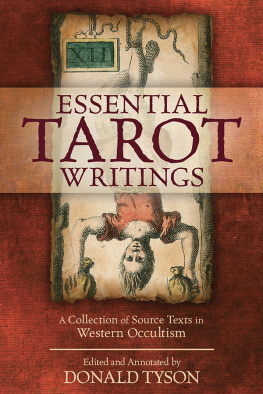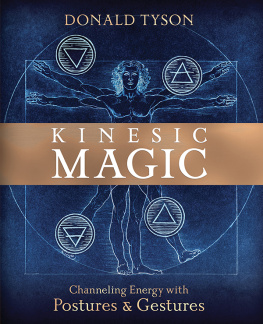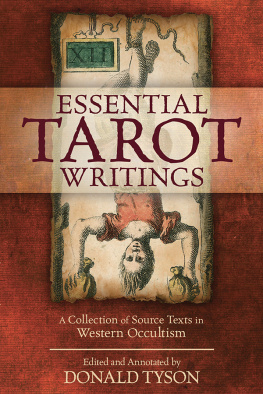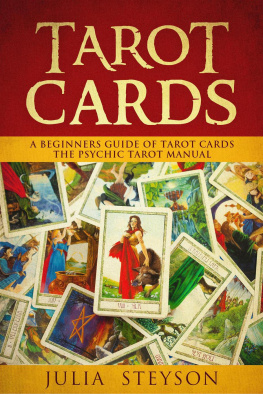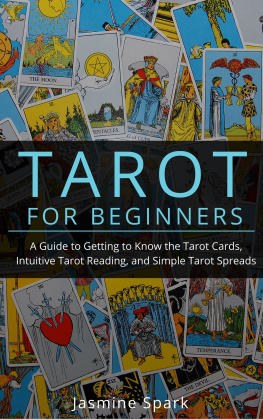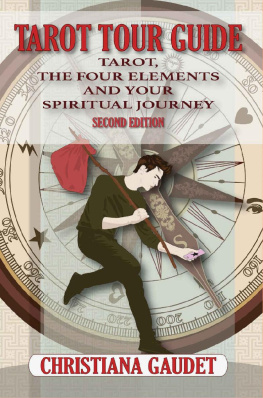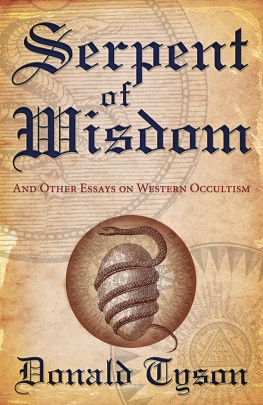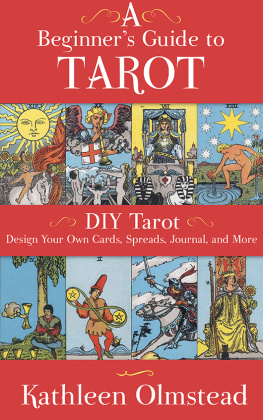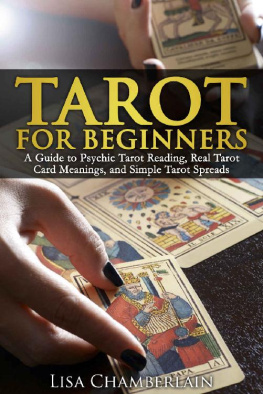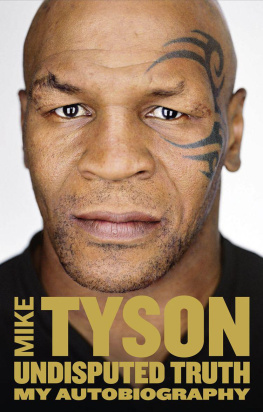Donald Tyson - Essential Tarot Writings
Here you can read online Donald Tyson - Essential Tarot Writings full text of the book (entire story) in english for free. Download pdf and epub, get meaning, cover and reviews about this ebook. year: 2020, publisher: Llewellyn Worldwide, LTD., genre: Religion. Description of the work, (preface) as well as reviews are available. Best literature library LitArk.com created for fans of good reading and offers a wide selection of genres:
Romance novel
Science fiction
Adventure
Detective
Science
History
Home and family
Prose
Art
Politics
Computer
Non-fiction
Religion
Business
Children
Humor
Choose a favorite category and find really read worthwhile books. Enjoy immersion in the world of imagination, feel the emotions of the characters or learn something new for yourself, make an fascinating discovery.
- Book:Essential Tarot Writings
- Author:
- Publisher:Llewellyn Worldwide, LTD.
- Genre:
- Year:2020
- Rating:5 / 5
- Favourites:Add to favourites
- Your mark:
- 100
- 1
- 2
- 3
- 4
- 5
Essential Tarot Writings: summary, description and annotation
We offer to read an annotation, description, summary or preface (depends on what the author of the book "Essential Tarot Writings" wrote himself). If you haven't found the necessary information about the book — write in the comments, we will try to find it.
Essential Tarot Writings — read online for free the complete book (whole text) full work
Below is the text of the book, divided by pages. System saving the place of the last page read, allows you to conveniently read the book "Essential Tarot Writings" online for free, without having to search again every time where you left off. Put a bookmark, and you can go to the page where you finished reading at any time.
Font size:
Interval:
Bookmark:


About the Author
Donald Tyson (Nova Scotia, Canada) is an occult scholar and the author of the popular, critically acclaimed Necronomicon series. He has written more than two dozen books on Western esoteric traditions.

Llewellyn Publications
Woodbury, Minnesota
Copyright Information
Essential Tarot Writings: A Collection of Source Texts in Western Occultism 2020 by Donald Tyson.
All rights reserved. No part of this book may be used or reproduced in any matter whatsoever, including Internet usage, without written permission from Llewellyn Publications, except in the form of brief quotations embodied in critical articles and reviews.
As the purchaser of this e-book, you are granted the non-exclusive, non-transferable right to access and read the text of this e-book on screen. The text may not be otherwise reproduced, transmitted, downloaded, or recorded on any other storage device in any form or by any means.
Any unauthorized usage of the text without express written permission of the publisher is a violation of the authors copyright and is illegal and punishable by law.
First e-book edition 2020
E-book ISBN: 9780738766348
Cover art of Hanged Man card from the Minchiate deck, courtesy of Lo Scarabeo
Cover design: Shannon McKuhen
Interior art:
cards are from Court de Gbelins Le Monde Primitif, vol. 8 (1781), with modifications by the author.
art is by Donald Tyson.
art is by Donald Tyson.
art is from The Secret Teachings of All Ages by Manly P. Hall.
art is from The Book of Days by Robert Chambers.
Llewellyn Publications is an imprint of Llewellyn Worldwide Ltd.
Library of Congress Cataloging-in-Publication Data
Names: Tyson, Donald, author.
Title: Essential tarot writings : a collection of source texts in Western
occultism / by Donald Tyson.
Description: First edition. | Woodbury, Minnesota : Llewellyn Worldwide,
[2020] | Includes bibliographical references and index. | Summary: This
book gathers together some of the most important, but most obscure,
essays on the esoteric Tarot that were written by prominent occultists
of the eighteenth, nineteenth, and twentieth centuries. Edited and
annotated by Donald TysonProvided by publisher.
Identifiers: LCCN 2020034204 (print) | LCCN 2020034205 (ebook) | ISBN
9780738765372 (paperback) | ISBN 9780738766348 (ebook)
Subjects: LCSH: TarotHistorySources. | Fortune-telling by
cardsHistorySources.
Classification: LCC BF1879.T2 T974 2020 (print) | LCC BF1879.T2 (ebook) |
DDC 133.3/2424dc23
LC record available at https://lccn.loc.gov/2020034204
LC ebook record available at https://lccn.loc.gov/2020034205
Llewellyn Publications does not participate in, endorse, or have any authority or responsibility concerning private business arrangements between our authors and the public.
Any Internet references contained in this work are current at publication time, but the publisher cannot guarantee that a specific reference will continue or be maintained. Please refer to the publishers website for links to current author websites.
Llewellyn Publications
Llewellyn Worldwide Ltd.
2143 Wooddale Drive
Woodbury, MN 55125
www.llewellyn.com
Manufactured in the United States of America
For my wife, Jenny,
my constant companion on
this mystery tour we call life.
Contents
by Antoine Court de Gbelin
by Louis Raphal Lucrce de Fayolle, the Comte de Mellet
Both essays translated from the French by Donald Tyson.
by P. D. Ouspensky
by Donald Tyson
by J. W. Brodie-Innes
Extract from by W. Wynn Westcott
by A. E. Waite.
by Manly P. Hall
from Breslaws Last Legacy .
I. by Phillip Breslaw
from The Universal Dream Book .
II. by Mother Bridget
from Chamberss Book of Days .
III.
from The History of Playing Cards .
IV.
from A Manual of Cartomancy .
V.
from Card Fortune Telling .
VI.
GENERAL INTRODUCTION
T he essays gathered together here span three centuries and two continents. The earliest was published in 1781 in Paris and the latest in 1928 in Los Angeles. What ties them together is their focus on the symbolism of cards, and the use of cards in the Western esoteric tradition for divination and practical magic.
The majority of these essays concern the Tarot, which became so central to Western occultism during the nineteenth century, first in France and then later in England and the United States; but the final part of the work deals with fortune-telling with common playing cards using what was known as the English Method . The primary characteristic of this method, popular in England from the seventeenth to the twentieth centuries, is its reliance on the full deck of fifty-two playing cards laid out in rows of nine. This method was included because the divinatory folk meanings for playing cards have many correspondences with the divinatory meanings for the Tarot, particularly with the Tarot folk meanings for the suit cards, and also because the method of divination by nines may be readily applied to the Tarot.
It would not be an exaggeration to say that the occult Tarot owes everything to France, and that it originated from the pen of a single man, Antoine Court de Gbelin, the author of the monumental Monde Primitif , a work on philology, linguistics, history, archaeology, philosophy, religion, and occultism in nine volumes that were published from 1773 to 1782. The essay by Court de Gbelin that opens this book appeared in the eighth volume, published in 1781, and it is without question the most important essay ever written on the occult Tarot.
Included by Court de Gbelin directly after his own essay was an essay on the occult Tarot by Louis Raphal Lucrce de Fayolle, the Comte de Mellet. Taken together, these two essays establish the place of the Tarot at the center of the modern tradition of Western magic. All that comes after was inspired by the work of these two men.
It was Court de Gbelin who fixed the origin of the Tarot in ancient Egypt. It was he who identified it as a symbolic book of Thoth, the Egyptian god of wisdom and magic. He also associated the Tarot with the Romanies and credited them with carrying it out of Egypt and spreading it throughout Europe. In the word Tarot he found the Egyptian root words for the royal way ( Ta-Ros ). The Tarot, he believed, was a sacred book of the Egyptian priesthood in which was concealed under a cloak of symbolism all their esoteric wisdom.
The Comte de Mellet supported the Egyptian origin of the Tarot. His essay is noteworthy for its explicit connection of the Tarot trumps with the Hebrew letters, which Court de Gbelin only hinted at, and for his arrangement of the trumps in three groups of seven cards each, coupled with the solitary unnumbered Fool, to which he assigned the zero. Court de Gbelin mentioned this threefold division of the trumps into sevens plus the Fool, but did not examine it at length. Comte de Mellet also compared the Tarot with common playing cards and wrote about the use of the cards for purposes of divination.
These ideas had a profound influence on the French occultists of the nineteenth century. They were adopted enthusiastically and uncritically to various degrees by such luminaries of the Western tradition as liphas Lvi, Paul Christian, Ren Falconnier, Papus, Stanislas de Guaita, and Oswald Wirth. It seemed not to matter that all these ideas were at best unsupported and at worst outright falsehoods. The French occultists embraced them and made the Tarot the centerpiece of their esoteric philosophy.
Font size:
Interval:
Bookmark:
Similar books «Essential Tarot Writings»
Look at similar books to Essential Tarot Writings. We have selected literature similar in name and meaning in the hope of providing readers with more options to find new, interesting, not yet read works.
Discussion, reviews of the book Essential Tarot Writings and just readers' own opinions. Leave your comments, write what you think about the work, its meaning or the main characters. Specify what exactly you liked and what you didn't like, and why you think so.

